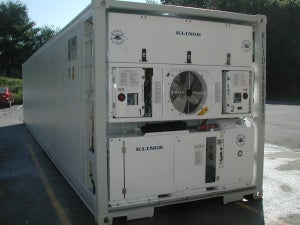
Rapid expansion into emerging markets as well as the increased number of cold chain pharma products requiring refrigeration during transit and storage has forced the pharmaceutical industry to consider alternative methods of temperature control.
The Pharmaceutical Commerce’s Biopharma Cold Chain Sourcebook reported that the market for temperature-controlled shipping is expected to rise nearly 17% from $6.5bn in 2010 to $7.6bn in 2013.
The increasing shift to growing and emerging markets in BRICM countries (Brazil, Russia, India, China, and Mexico) coupled with the rise of biotech products requiring refrigeration during storage and transport has made the supply chain much more complex. Companies must deal with several security concerns, inadequate transport infrastructure, product integrity, country-specific regulatory obstacles and vastly different temperature ranges and climates.
While ocean transport in refrigerated shipping containers, or ‘reefers’, has been considered by pharmaceutical companies as a cost efficient solution, it is not widely viewed as a solution for high value goods.
Contrary to this viewpoint, specialized refrigerated containers are the ideal storage and transport solution for cold chain pharma supplies. Dual refrigeration, back-up power supply, and a satellite monitoring and temperature recording system ensure safeguarding of valuable pharmaceuticals.
Specialized dual refrigeration systems safely and reliably keep pharma products at their required temperature at a low cost
Pharmaceutical companies can safely store and transport pharmaceuticals in Dual Refrigerated Containers (active refrigeration system) such as those provided by Klinge Corporation.
Klinge Corp Sales Manager, Jason Flynn says: "Klinge Corp’s Dual Refrigerated Containers give pharmaceutical companies peace of mind as the risk of temperature deviations are essentially zero."
"The system is comprised of a shipping container with two full capacity refrigeration systems whereby the refrigeration unit automatically switches to its back-up in case of emergency," he added.
The use of this ultra-reliable dual refrigeration system is critical when transporting temperature-controlled pharmaceuticals in emerging markets that have inadequate infrastructure, wide ranging climates and temperatures, and regulatory obstacles.
The number of pharma products that must be kept at controlled room temperature (15°-25°C) has increased dramatically and the temperature and storage regulations for these products are tightening. In addition, the majority of biotech products (as well as vaccines and blood products) require cooling between 2°C and 8°C.
Klinge Corp’s transport solution for cold chain supplies is especially capable of maintaining the common temperature requirements of 15°-25°C (room temperature) and 2°C and 8°C.
In fact, the equipment is capable of maintaining temperatures from -29°C to +29°C. The equipment was built to withstand harsh climates and severe atmospheric conditions.
Adding to the fail-safe dual refrigeration system is the integral generator set
The diesel generator set powers the dual refrigeration systems during transport when power is not available, such as during transport on a truck, or in a shipyard. This is particularly important if the shipment is held up due to customs, or extensive road transport.
Like the refrigeration systems, the generator set was designed to meet the rigorous demands of ocean, over-the-road, and rail transport.
Satellite monitoring and temperature recording systems ensure data integrity and safekeeping of pharmaceutical supplies
Safety and security of pharma products is paramount. Klinge Corp offers a satellite communication system that communicates cargo temperature, location, alarm status and power source in near real-time. The data is accessible on a password-protected website for each individual customer. Alerts can be emailed and text messaged to the customer’s desired personnel.
This technology prevents temperature excursions from occurring as the data is tracked and monitored during storage and transport.
In addition, the Dual Refrigerated Container comes with a temperature recorder that displays and stores temperatures and alarm status. All data is stored with a date/time stamp in a large flash memory. Data will not be lost if power supply is disconnected. The temperature recorder is also available with a printer for quick printing.
"The superior reliability of the Dual Refrigerated Container is supplemented by the system’s back-up power supply, satellite monitoring system, and temperature recorder. These features allow cold chain supplies to be transported by ocean and provides companies with control over their supply chain at a significantly lower cost than air transport," says Allan Klinge, Senior Project Manager, Klinge Corp.
Proven solution for high value goods requiring temperature control
Ocean transport for high value goods requiring refrigeration is a viable, cost-efficient, and most importantly, safe option. A case in point is the United Kingdom’s Antarctic operation, who purchased Klinge Corp’s Dual Refrigerated Container System through Raytheon Polar Services Company, to store and transport ice core samples from Antarctica to the United States.
Valued at several millions of dollars, the ice core samples were kept at their required temperature in Klinge Corp’s Dual Refrigerated Containers from Rothera Station in the South Pole, across the equator, and to a research lab at Ohio University.
"Given the monetary and scientific value of the ice core samples, it was absolutely critical that Klinge Corp safely store and transport the temperature-sensitive goods," says Jason Flynn.
"Additionally, our Dual Refrigerated Containers have been used by leading chemical and pharmaceutical companies for the last 30 years."

